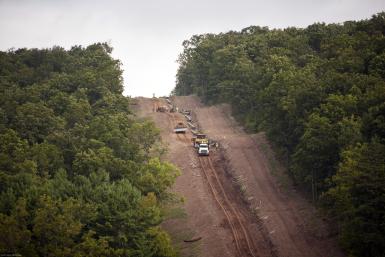
Shafer, Craig L. Nature Reserves: Island Theory and Conservation Practice. Washington, DC: Smithsonian, 1990.
This book is a fine introduction to one aspect of the evolving science of ecology, and brings to light much of the ongoing policy formulation dealing with the world’s remaining wildlands. While Shafer’s writing style is certainly more in tune with the postgraduate ecology classroom or the bowels of an environmental think-tank, he is generally able to make himself understood to the patient layman (particularly those, like law students and political reporters, with a high tolerance for seemingly meaningless abstractions).
With graphs, flow charts, plot curves and much trigonometry, the author outlines the basics of island biogeographic theory. What this fairly recent formulation essentially boils down to is the fact that wildlife, particularly large fauna and predators, cannot long survive the fragmentation of a contiguous ecosystem without (1) die-off, (2) emigration, or (3) genetic impoverishment leading to the decline of species viability and resistance to disease. Furthermore, while some few remaining natural regions, such as the Greater Yellowstone Ecosystem, have enough territory within and surrounding the protected area itself to ensure the diversity and health of animal and plant genera, most parks are far removed from other refuges and are thus subject to species atrophy and decline. Parks like those that are typical in the East (e.g. Acadia National Park in Maine) are generally surrounded by developed acreage, especially suburban and “second-home” development. Even such large, seemingly protected national parks as Great Smokies and Everglades are encircled by anthropogenic perturbation that serves to confine and isolate the species therein. The lands surrounding Great Smokies National Park suffer most obviously from a berserk array of cheap tourist development, exemplified in the Elvis wax museums and “Dan’l Boone Log Flumes” of the Vegas-style hayseed zoo called Pigeon Forge. The Everglades face the draining and poisoning of its vital fresh water supplies, courtesy of the omnipotent sugar industry, and the habitat losses daily perpetrated by the creeping suburbs of Miami.
What is called for, in a scenario that stresses continued development within an intact ecosystem, is a “buffer zone” of limited, sustainable human activity (such as organic farming or low-yield pastoralism) that rings a protected “core area” of park or refuge, within with the natural biota would generally be allowed to exist in peace. These core areas should be connected by protected “corridors” such as vegetated riverbanks that would allow for the genetic transfer of faunal populations—animal migration. Without the opportunity for fresh population influx, isolated natural areas are left to genetically wither into dwindling groups of inbred, increasingly sterile individuals (the highly endangered Florida panther is a sad example). Shafer makes it clear that what is needed in modern biological decision-making is a full accounting for the territorial needs of isolated species, as well as the political will to string together the pathetic remnants of our wild heritage.
This book is a fine introduction to one aspect of the evolving science of ecology, and brings to light much of the ongoing policy formulation dealing with the world’s remaining wildlands. While Shafer’s writing style is certainly more in tune with the postgraduate ecology classroom or the bowels of an environmental think-tank, he is generally able to make himself understood to the patient layman (particularly those, like law students and political reporters, with a high tolerance for seemingly meaningless abstractions).
With graphs, flow charts, plot curves and much trigonometry, the author outlines the basics of island biogeographic theory. What this fairly recent formulation essentially boils down to is the fact that wildlife, particularly large fauna and predators, cannot long survive the fragmentation of a contiguous ecosystem without (1) die-off, (2) emigration, or (3) genetic impoverishment leading to the decline of species viability and resistance to disease. Furthermore, while some few remaining natural regions, such as the Greater Yellowstone Ecosystem, have enough territory within and surrounding the protected area itself to ensure the diversity and health of animal and plant genera, most parks are far removed from other refuges and are thus subject to species atrophy and decline. Parks like those that are typical in the East (e.g. Acadia National Park in Maine) are generally surrounded by developed acreage, especially suburban and “second-home” development. Even such large, seemingly protected national parks as Great Smokies and Everglades are encircled by anthropogenic perturbation that serves to confine and isolate the species therein. The lands surrounding Great Smokies National Park suffer most obviously from a berserk array of cheap tourist development, exemplified in the Elvis wax museums and “Dan’l Boone Log Flumes” of the Vegas-style hayseed zoo called Pigeon Forge. The Everglades face the draining and poisoning of its vital fresh water supplies, courtesy of the omnipotent sugar industry, and the habitat losses daily perpetrated by the creeping suburbs of Miami.
What is called for, in a scenario that stresses continued development within an intact ecosystem, is a “buffer zone” of limited, sustainable human activity (such as organic farming or low-yield pastoralism) that rings a protected “core area” of park or refuge, within with the natural biota would generally be allowed to exist in peace. These core areas should be connected by protected “corridors” such as vegetated riverbanks that would allow for the genetic transfer of faunal populations—animal migration. Without the opportunity for fresh population influx, isolated natural areas are left to genetically wither into dwindling groups of inbred, increasingly sterile individuals (the highly endangered Florida panther is a sad example). Shafer makes it clear that what is needed in modern biological decision-making is a full accounting for the territorial needs of isolated species, as well as the political will to string together the pathetic remnants of our wild heritage.
